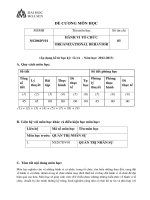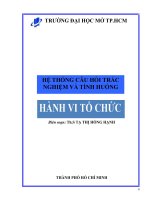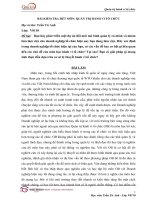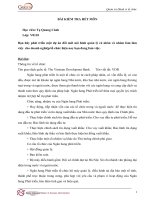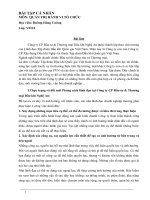Đề cương trắc nghiệm Hành Vi Tổ Chức (Organizational Behavior) CHƯƠNG 5
Bạn đang xem bản rút gọn của tài liệu. Xem và tải ngay bản đầy đủ của tài liệu tại đây (40.05 KB, 12 trang )
Chapter 5: Stress Management
5-1. General adaptation syndrome involves which of these stage
sequences?
a.
Alarm reaction, resistance, exhaustion
b.
Emotional exhaustion, depersonalization, reduced
personal accomplishment
c.
Adaptation, reduction, dissemination
d.
Ambiguity, clarity, confusion
e.
Resistance, ambiguity, depersonalization
5-2. During which stage of the general adaptation syndrome is it
that a person's ability to cope with the environmental demand
rises above the normal state?
a.
Exhaustion
b.
Alarm reaction
c.
Perception
d.
Resistance
e.
None of the above
5-3. Employees who face competing demands are experiencing:
a.
A role-related stressor.
b.
A physical environment stressor
c.
An interpersonal stressor
d.
Type B behaviour pattern
e.
A temporary withdrawal strategy
5-4. Technostress refers to:
a.
An interpersonal stressor caused by recent information
technologies
b.
The general adaptation syndrome observed through
monitoring equipment.
c.
a role-related stressor caused by recent information
technologies.
d.
Stress caused by information systems employees after
an incident of workplace violence.
e.
The technical process of avoiding job burnout
5-5. Situations in which a person's employment or job
performance is conditional on unwanted sexual relations refers
to
a.
hostile environment.
b.
strain-based conflict.
c.
role ambiguity.
d.
quid-pro-quo.
e.
role conflict.
5-6. Time-based conflict mainly refers to:
a.
The challenge of performing a job that requires more
skill and knowledge than you currently possess.
b.
The most common outcome of job burnout.
c.
The conflict that people experience when they possess
a Type B behaviour pattern.
d.
All of the above
e.
None of the above
5-7. When people who act logically and impersonally at work
have difficulty switching to a more compassionate role in their
personal lives, they are experiencing which of these?
a.
Technostress
b.
Interpersonal conflict
c.
Role-behaviour conflict
d.
Time-based conflict
e.
Strain-based conflict
5-8. Which of these is generally identified as a high stress
occupation?
a.
Artist
b.
Telephone operator
c.
Forester
d.
Accountant
e.
Auto mechanic
5-9. People with a Type A behaviour pattern tend to:
a.
Have a relaxed approach to life.
b.
Have a low concern about time limitations.
c.
Contemplate issues carefully.
d.
work at a steady pace.
e.
easily lose their temper.
5-10. Which of these is a characteristic of a Type B behaviour
pattern?
a.
Struggles to perform several tasks
b.
Devoted to work
c.
Talks rapidly
d.
Low concern about time limitations
e.
Interrupts others
5-11. Which of the following activities tries to manage stress by
controlling its consequences?
a.
Improved person-job matching
b.
Work breaks
c.
Meditation and relaxation
d.
Seminars that increase self esteem
e.
All of the above
5-12. Which of these is a behavioral consequence of distress?
a.
Sleep disturbances
b.
Moodiness
c.
Burnout
d.
Workplace aggression
e.
Depression
5-13. Which of the following is NOT explicitly mentioned in the
job burnout model?
a.
Alarm reaction
b.
Depersonalization
c.
Emotional exhaustion
d.
Reduced personal accomplishment
e.
Role-related stressors
5-14. Which of the following removes stressors from the
workplace?
a.
Child care facilities
b.
Flexible work hours
c.
Empowering employees
d.
Matching employee competencies with job
requirements
e.
All of the above
5-15. Relaxation and meditation:
a.
Are interpersonal stressors.
b.
Control the physiological consequences of stress.
c.
Usually remove the sources of stress.
d.
Minimize stress mainly through social support.
e.
Tend to increase rather than minimize stress in the
workplace.
TRUE or FALSE
5-1. Eustress is the stress experience in moderation, enough to
activate and motivate people.
True
False
5-2. Resistance is the first stage of the stress experience (i.e., the
general adaptation syndrome).
True
False
5-3. Sexual harassment represents a type of interpersonal
stressor.
True
False
5-4. Canadians are less likely than Americans of experiencing
workplace assault.
True
False
5-5. Time-based conflict is more acute for women than for men.
True
False
5-6. Hospital manager, telephone operator, and waiter/waitress
are usually identified as low-stress occupations
True
False
5-7. Regarding job performance, Type B people tend to work
faster than Type A people and are more effective in jobs
involving time pressure.
True
False
5-8. Cardiovascular diseases represent one of the most
disturbing effects of stress or modern society.
True
False
5-9. Job burnout is most common among people who serve and
frequently interact with others.
True
False
5-10. Workplace aggression represents the "flight" reaction to
stress.
True
False
5-11. Coffee breaks and playing games in the hallway manage
stress by temporarily withdrawing from the stressor.
True
False
5-12. Changing stress perceptions is an ineffective way to
minimize stress because nothing really changes.
True
False
5-13. Relaxation and meditation reduce stress mainly by
controlling the physiological consequences of stress.
True
False
